Ballycaseymore
Houses within 15km of this house
Displaying 119 houses.
Houses within 15km of Ballycaseymore
Displaying 119 houses.
| House name | Description | |
|---|---|---|
| Fort Fergus | A home of the Ross Lewin family in the 18th and early 19th centuries. In 1786 Wilson refers to it as the seat of J. RossLewin. Occupied by Mr Evans in 1814 and by Daniel O'Grady in 1837 and held by Major William Ball in fee in the 1850s, when the buildings were valued at over £32. Bence Jones writes that Major Ball purchased Fortfergus in 1855 in the Encumbered Estates' Court. Weir writes that the house was burnt down in the 1920s. The remaining staff quarters have been turned into a residence and the farm buildings are still in use. | |
| Dangan | The main residence of the Creagh family in the 18th and 19th centuries, held by Cornelius Creagh in fee at the time of Griffith's Valuation when the house was valued at over £25.. Sold in the 1920s, the Irish Tourist Association Survey file records the house as dilapidated and going to ruin in the 1940s. Weir writes that the house was demolished in 1948. | |
| Cragbrien | An 18th century house of the Stacpooles which Wilson notes as "the beautiful seat of Mr. Stacpole" in 1786. It passed to the Stacpoole Mahons in the early 20th century and is still occupied. Matthew Kelly of Cragbrien owned 562 acres in county Clare in the 1870s. |

|
| Claremount House | Claremount house and demesne were part of the Barntick estate. Occupied by Jonas Studdert in 1814 and by Wyndham F. Patterson at the time of Griffith's Valuation. His lease expired on 25 Mar 1857. It was then leased to the Lynch family. One descendant was Patrick Lynch, Senator of the Irish Free State and Attorney General of Ireland 1936-1940. | |
| Barntick | A 3 storey house dating back to the 17th century, it was originally a Hickman home. The Hickmans sold the property to the Peacockes in the mid 18th century. In 1786 Wilson refers to it as the seat of Mr. Peacocke. Occupied by Daniel Powel in 1814 the house was later owned by the Roche family of Limerick and leased to the Lyons, who eventually bought the property. Now owned by the Murphy family through marriage with a member of the Lyons family. |
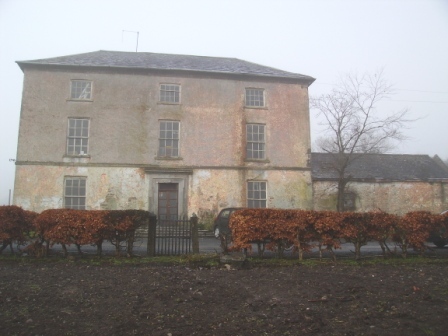
|
| Buncraggy | A home of the Burton family in the 18th century though Wilson refers to it as the seat of Mr. Armstrong in 1786. It was held by James O'Gorman from the Marquess of Conyngham at the time of Griffith's Valuation. The house remained in the possession of the O'Gorman family until the end of the 19th century when it became the property of the Caher family. The house is still occupied and the yard buildings are the centre of a farming enterprise. |

|
| Islandmagrath House | Originally a Burton property bought from the Earl of Thomond, Islandmagrath was leased to Edward Maunsell by the Marquess of Conyngham at the time of Griffith's Valuation. It is described as "steward's house", with a £10 valuation. A house and farm buildings are still extant at the site. | |
| Carnelly | An 18th century three-storey Georgian house, probably designed by Francis Bindon (1690-1765), home of the Stamer family in the 18th century and for much of the 19th century. In 1786 Wilson refer to it as the seat of William Stamer. It passed through marriage to Francis N. Burton of Carrigaholt and then to the O'Grady family. Carnelly House was let from 1840-1849 to John O’Brien of the Ballynalacken family, Member of Parliament for Limerick. His fifth son ‘Peter the Packer’, the notorious crown prosecutor, was born there in 1842. Peter O’Brien was appointed Attorney General in 1888, received a knighthood in 1891 and was created Baron Kilfenora in 1900. After 1922 distinguished historian Mr Justice Gleeson came to live at Carnelly and the Gleeson family are still resident. It was offered for sale in 2013. |

|
| Manus House | Weir writes that John Hartigan of Manusmore was the Clare County Surveyor. He died in 1756. Manusmore was occupied by Thomas Lynch in 1814 and by Terence Healy at the time of Griffith's Valuation. Other occupiers in the latter half of the 19th century were George Walton and Hugh Tarpey. The McInerneys of Ennis bought the farm in the 1890s and have lived there for over a hundred years. | |
| Manus South House | Weir writes that this house was built by the Healy family. It was occupied by James Healy at the time of Griffith's Valuation and was valued at £20. Both Healy houses at Manusmore were leased from Colonel George Wyndham. This house is now the home of the O'Halloran family. | |
| Castlecrine | Weir writes that this was an 18th century residence possibly incorporating the 16th century tower. Castlecrine was the home of a branch of the Butler family for most of the 18th and 19th centuries, valued at £45 at the time of Griffith's Valuation, it was demolished in the mid 20th century. |

|
| Castlelake | Home of the Gabbett family in the 19th century, occupied by Robert Gabbett in 1814 and by John Gabbett in 1837 and in the 1850s. They held the property from the Westropp family with whom they intermarried. Home of the Carroll family in the second half of the 20th century, still occupied. | |
| Ieverstown | A house held by John A. Ievers in fee at the time of Griffith's Valuation when the building was valued at £11.10 shillings. Still inhabited it stands close to the road. | |
| Mount Ievers | A house built in the 1730s by Henry Ievers to the design of John Rothery. Wilson refers to it as the seat of Mr. J.A. Ievers in 1786. Occupied by Robert Ievers in 1814 and by W. Ivers in 1837. Eyre Ievers was resident at the time of Griffith's Valuation, holding the property from James Ievers. The Ievers family still live in the house. |

|
| Ballintlea | Weir writes that the original house dates from 1696. Ballintlea was occupied by John Kelly in 1837, who is recorded as holding the property in fee at the time of Griffith's Valuation. The Kellys appear to have bought Ballintlea from the D'Esterres. The Kelly and Kelly Roche families have resided there ever since. Fitzjames Kelly was in possession in 1906. | |
| Cratloe Woods | An 17th century house with a 19th century addition, the Irish home of the Stafford O'Briens and still in the family's possession. On the first edition Ordnance Survey map this house appears to straddle the border of the townlands of Cratloe and Portdrine. The house was held by Augustus Stafford at the time of Griffith's Valuation, valued at £24. In 1894 it was the seat of F.H.Stafford-O'Brien. It is still extant. |
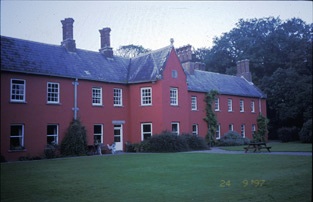
|
| Burtonhill House | Weir writes that this house was probably built by the Carrigaholt Burtons as a sporting lodge. It is marked on the first edition Ordnance Survey map. The Burton Conynghams had a large estate in the parish of Killeely so there can be no doubt that the house was named after them. By the time of Griffith's Valuation it was valued at £11 and Edward H. Goggin was in residence. He held the property from Mrs Taylor. William B. Goggin of Burton Hill married Frances Maria Whitestone in the second half of the 19th century. see http://brew.clients.ch/RichardClare.htm | |
| Summerhill House | Built on the Marquess of Conyngham's estate by the time of the first Ordnance Survey, this house valued at £10 was occupied by John Frost in the mid 19th century and it continued to be the home of the Frosts until the 1970s. A substantial farm still exists at the site. | |
| Meelick House | A house built by the time of the first Ordnance Survey on the Marquess of Conyngham's estate and occupied by William Roche at the time of Griffith's Valuation, when it was valued at £11. This house is no longer extant. | |
| Cratloe House | Another house belonging to the Stafford O'Brien family, held by Augustus Stafford in fee at the time of Griffith's Valuation and valued at £12. Lewis records this house in the parish of Killeely and Cratloe Woods in the parish of Kilfintinan. Leet records Don O'Brien as resident at Cratloe, county Limerick, in 1814. In 1786 Wilson refers to Cratlagh-Hall as a seat of Mr. O'Brien. Possibly either part of the same building complex as Cratloe Woods or the nearby premises labelled Cratloekeel Castle on both the 1st edition and 25-inch Ordnance Survey maps. | |
| Ballycannan | A house held by James Gloster in fee at the time of Griffith's Valuation and valued at £20. This house is marked on the first Ordnance Survey map. | |
| Ballysheen | A house on the Vandeleur estate, occupied by the Walton family for most of the 19th century. Occupied by George Perry in 1814. Valued at £10 at the time of Griffith's Valuation it was renovated in the 20th century. Labelled as Walton Lodge on the 25-inch Ordnance Survey map of the 1890s. |
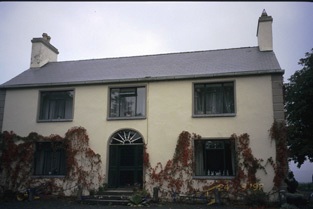
|
| Ballycunneen | Hogan writes that this house was built in 1805 by Thady, son of Thady O'Halloran the diarist, in front of the old Hickey house. Marked on the first Ordnance Survey map this house was occupied by Stephen O'Halloran who held the property from Colonel George Wyndham. It was valued at £15 and had 159 acre demesne. The house is still extant. | |
| Firgrove | Hogan writes that the building of Firgrove was begun by Thomas, son of Thady O'Halloran, the diarist, and completed by John MacMahon of Knockane. John Peter Kelly took over the house from MacMahon. In 1851 Eliza, daughter of John Scott of Firgrove, married George Fosbery of Clorane, county Limerick. The house was occupied by Charles Butler in the mid 19th century who held the property from John Kelly. It was valued at £35. The house was demolished in the 1920s. |

|
| Deerpark | Home of the Daltons for much of the 18th century. Occupied by Simon O'Donnell in 1814 and by Edward Maunsell (son of George of the Ballywilliam, county Limerick family) in 1837 and at the time of Griffith's Valuation, when it was valued at £30. Maunsell held the property from Matthew Canny. Inherited by Maunsell's fifth son Thomas. It was sold to Shannon Development in the 20th century. | |
| Rossmanagher House | A D'Esterre home, occupied by Lieutenant Colonel William O'Brien in 1837 and by Solomon Frost in the mid 19th century, when it was valued at £7. Historians and archaeologists believe that this building, some of which still survives, dates to the sixeenth or seventeenth century. | |
| Rossmanagher Cottage | The house in the townland of Newpark is named Rossmanagher Cottage on the first Ordnance Survey map. This was another D'Esterre home, occupied by Richard K. D'Esterre at the time of Griffith's Valuation, valued at £10 and held from Caleb Powell. The remains of a building are still extant at the site. | |
| Springfield | Weir writes that the Morice family probably built this house which was located on the Wood estate. It is recorded as the residence of Henry Wilson in 1814 and of F. Morice in 1837. Griffith's Valuation records that Francis Morice held the property from George A. Wood in the mid 19th century. The house was valued at £28. This house which was renovated is still inhabited. | |
| Carrigerry | Built in the late 18th century, this house was occupied by John O'Halloran in 1814 and by Major Creagh in 1837. Mary Creagh, who held the property from Francis Macnamara was in residence in the mid 1850s. The house is now a country hotel run by Mr and Mrs N. Ennis see http://www.carrygerryhouse.com/index.html |

|
| Cahirbane | Home of the Creagh family throughout most of the 18th and 19th centuries. It was occupied by Captain James Creagh at the time of Griffith's Valuation when it was valued at £25. The original house was larger than the 20th century construction now in existance. | |
| Lismoyle | This house dates from circa 1841 when it was the residence of T. O'Donoghue. At the time of Griffith's Valuation it was the home of Patrick O'Donoghue who held the property from Mary O'Grady. Occasionly used as a shooting lodge by the O'Grady family and it remained in their possession until the 20th century. | |
| Ballygirreen | At the time of Griffith's Valuation Ballygirreen was occupied by Francis O'Donohoe who held the property from Lord Inchiquin. The value of the buildings was £12 in the mid 1850s and in 1906. A house is still extant at the site. | |
| Shepperton | Castlekeale and Shepperton or Shepherdsfield houses were both located in the townland of Ballysallagh West. Weir writes that the Fitzgerald family moved from Castlekeale to Shepperton in the latter part of the 18th century. The house appears to have been leased out to many different people, such as John Wrixton in 1814, John Gabbutt in 1837 and Captain William J. Owen in the 1850s when the house was valued at £22. Weir writes that the house is now demolished. | |
| Carrigoran | An 18th century house the residence of the Fitzgerald family in the 18th and 19th centuries. Griffith's Valuation shows that the house was valued at £45 in the mid 19th century and that it was held by Sir Edward Fitzgerald from Matthew Rosengrave. An earlier house reputedly destroyed by fire in the late 18th century stood nearby. The house was bought by the Sisters of Charity of the Incarnate Word in the 1920s. The house was still in use in the 1940s but was demolished in the 1980s. |
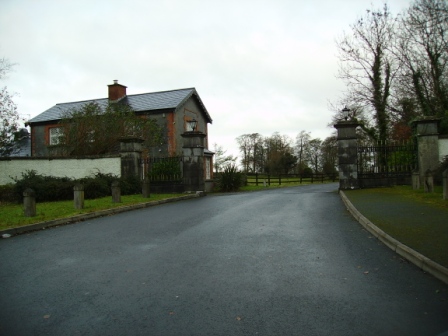
|
| Cappaghlodge | A property in the possession of the Spaight family from the early 18th century. The house named "Lodge" was the residence of Samuel Spaight in 1814. James Kelly held the property from the representatives of Edward Spaight Ferreter at the time of Griffith's Valuation, when the house was valued at £18. It was in the hands of the Court of Chancery at this time. In 1906 the house valued at £11 was in the possession of James Frost. Weir writes that the house is now demolished. | |
| Russell Villa | An early 19th century house built on the Dromoland estate, the home of the Russell family in the 19th and 20th centuries. The building is still extant. | |
| Kilkishen | An 18th century house that passed into the Studdert's possession throught a marriage with a Cusack of Kilkishen. The house was valued at £40 in the mid 19th century. Slater notes it as the residence of Maj. R.A. Studdert in 1894. It remained a Studdert home until sold to the Binghams in the 1920s. A house is still extant at the site. |
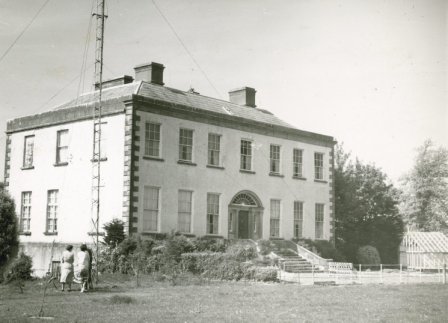
|
| Bunratty | Built in 1804 for Thomas Studdert, it was a Studdert home throughout the 19th century and for part of the 20th century. The house was used by Shannon Development as their offices for some time and it is now part of the Bunratty Folk Park. | |
| Bunratty Castle | In the 1680s Bunratty was the principal seat of the Earl of Thomond. In the early 18th century the castle and demesne were leased to Thomas Studdert by the Earl of Thomond and the castle became a Studdert residence. In 1786 Wilson refer to a seat of Mr. Studdert at Bunratty. For some time in the mid 19th century it served as an Royal Irish Constabulary barracks. In 1894 it was the seat of Capt. Richard Studdert. |

|
| Bunratty Lodge | Originally a Spaight home, inhabited by Richard Dawson and his wife Ellen Studdert. Richard Dawson was the third son of Charles Dawson of Charlesfort, county Wexford and left an only son also named Richard who lived in this house at the time of Griffith's Valuation, holding it from Thomas Studdert. In 1837 Lewis wrote that this house immediately adjoined the village of Bunratty and was the residence of Mrs Paliser. | |
| Clonmoney West | An early 18th century house, built and owned by the Westropps until the 20th century. The O'Donnells were resident at the end of the 18th century. It was leased to Henry White in 1814 and to D. Canny in 1837. Matthew Canny held Clonmoney from John Westropp in the mid 19th century, when the property was valued at £25. The Cannys subleased the property to Michael Macnamara. The executors of Macnamara's will advertised the sale of his interest in Clonmoney in January 1880. The original house is not extant now. |

|
| Woodpark | Weir records the marriage of Michael Dalton and Mary Anne Fitzgerald of Castlekeale in 1761. Woodpark was the residence of M. D'Alton in 1837 and of John Kennedy in the mid 1850s. The house was in ruins in the early 20th century. |

|
| Shannon Grove | Located on the estate of Sir Edward Fitzgerald this house was occupied by John Coffey at the time of Griffith's Valuation. The property was sold to the Hegarty family in the 1920s. It was labelled Shannon Grove on the 1st edition Ordnance Survey map but as Crow Hill on subsequent editions. A house and extensive farm are still extant at the site. | |
| Ballymurtagh | A house on the Miller estate, leased to John Kelly in the mid 19th century, when it was valued at £12. Weir writes that it was demolished due to its proximity to Shannon Airport runway. | |
| Knockaun | The home of the McMahon family located on the Miller estate, they farmed 121 acres as a demesne. The residence of Patrick McMahon in 1814. Lewis records Knockhane as the residence of P. McMahon in 1837. The house was valued at £8 in the mid 19th century. | |
| Castlepark | The original building was a residence of the O'Briens of Thomond. Wilson, writing in 1786 refers to Castle-Park as the seat of Mr. Smith. In 1789 it became Ormsby property and was named Blackland Castle. The home of William Maunsell in 1814. In 1833 it became the property of Christopher Delmege who rebuilt most of it. The Ordnance Survey Field Name Book describes it as "a splendid edifice 4 story high overlooking the Shannon and estimated at £2,000." The house was valued at £55 in the early 1850s and Christopher Delmege held it from the Marquess of Lansdowne. It was the seat of James O'Grady Delmege in 1894. Occupied by James Lyons, Limerick city coroner in the late 20th century, the house was gutted by fire in 2001 and for sale in 2007 for 40 million euro (Irish Independent 20 Dec 2007). Caste Park remains derelict. |
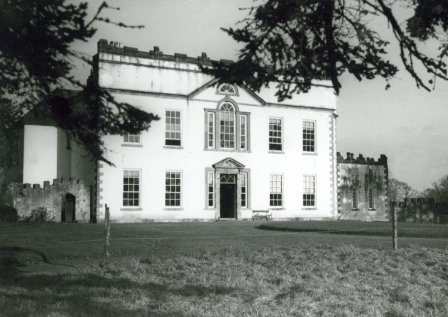
|
| Dromoland | This branch of the O'Briens have lived at Dromoland since the 17th century when they moved from Leamaneh Castle near Corofin to Dromoland. The present building was constructed in the 1830s to the design of James and George Richard Pain replacing an earlier house. In 1962 it was sold to Bernard McDonough, an American of Irish descent, who turned it into a top class hotel. The present Baron Inchiquin lives in Thomond House nearby. |
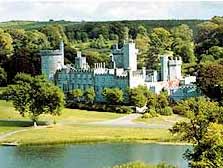
|
| Latoon House | A 19th century house on the O'Brien estate, occupied by John Lynch in the mid 1850s and valued at £18. | |
| Newmarket House | Home of a branch of the Studdert family in the 19th century. It was described by Lewis in 1837 as the "spacious mansion of C. Studdert". It was occupied by his widow Maria at the time of Griffith's Valuation. She held the property from Lord Inchiquin and it was valued at £25. Sold by the Studderts at the beginning of the 20th century. | |
| Ballycar | Home of the Colpoys family in the 18th and early 19th centuries. Wilson refers to it as the seat of Mr. Colpoys in 1786. It passed by marriage to the O'Callaghan family. The sale rental of 1850 describes Ballycar as a cottage style residence with 'a fine garden attached'. By the time of Griffith's Valuation the house was occupied by Edward Bennett who held the property from the Misses Abbott. At this time it was valued at £18. A house is still extant at the site. | |
| Fenloe House | A red brick two storey 18th century house, home of the Hickman family for the 18th and 19th centuries. Hugh Poole Hickman was the occupier in 1837 and at the time of Griffith's Valuation, when the house was valued at £28. He held the property from William Westby. |
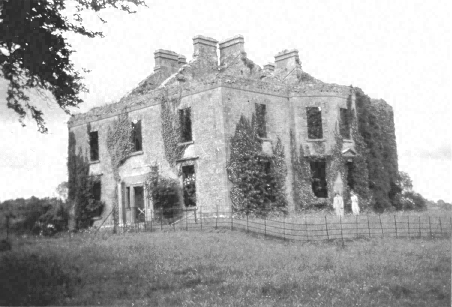
|
| Granaghan | The home of the Hewitt family on the Moloney estate. Mr Tim Donoghoe was the occupier in 1814 The old house is now largely demolished and a new house has been erected on the site. The house valued at £12 was held by Thomas Hewitt from Croasdaile Moloney in the mid 19th century. | |
| Rathlaheen House | A pink three storey house, home of a branch of the Vandeleur family in the 18th and early 19th centuries. In 1786 Wilson refers to it as the seat of Boyle Vandeleur. Also occupied by Boyle Vandeleur in 1814 and by John Scott Vandeleur in 1837 according to Lewis. It was the centre of the famous Rathlaheen Co-operative in the early 19th century. Following the bankruptcy of John Scott Vandeleur in the 1830s Pierce Creagh occupied the house holding it from the Vandeleurs. It later became a Stoney home. They were resident in 1906. The house is no longer extant. | |
| Castlefergus | A Blood Smyth property from the late 18th century, sold by the Blood Smyth to the Bloods of Ballykilty in the early 20th century. This house was occupied by Daniel Powell in 1814 but the Blood Smyths were in residence in the 1830s and 1850s. They appear to have held the property from Ralph Westropp. The mansion house of Castlefergus was in the possession of Rev William Blood Smith in 1906. The Irish Tourist Association Survey File records that the house was demolished by the Irish Land Commission. | |
| Moyriesk | Lewis writes that the finely wooded property of Lord Fitzgerald and Vesey was bought by his father from the Macnamaras. Occupied by George Sampson at the time of Griffith's Valuation, when it was valued at £35. Moyriesk was accidently burnt in 1875 though Slater still notes it as a property owned by them in 1894. |

|
| Hazelwood | Occupied by Hugh Singleton in the mid 19th century and held from the representatives of Charles Mahon. The buildings were valued at £31. The house remained a Singleton residence until it was burnt in 1921. | |
| Ballykilty | A McMahon residence in the 1730s, In 1786 Wilson notes it as the seat of Mr. McMahon. Weir writes that the lease of Ballykilty was purchased by John Blood in 1785. Occupied by Robert Young in 1814 and by John Blood in 1837 and at the time of Griffith's Valuation. He held the property from William Monsell. The front of the house was replaced following a fire in the 19th century. Functioned as a hotel in the latter part of the 20th century and now the site of a major hotel development. | |
| Craggaunowen Castle | 16th century tower house, "in ruins" at the time of the first Ordnance Survey. The castle, herd's house and 96 acres were in the possession of the Reverend William Ashworth in the mid 19th century, who held them from a Caswell. A mansion house valued at £13 was in the possession of Count James Considine in 1906. The castle was bought by John Hunt in the mid 1960s and was the first home of the Hunt Museum. | |
| Cullane House | A house built in the 1780s, also known as Lough O'Connell. It was the home of Thomas Steele and in 1821 passed to his nephew "Honest Tom" Steele, friend of Daniel O'Connell. In the late 1840s Cullane was inherited by Tom Steele's niece who had married Charles Studdert of Newmarket House. Their son Robert Wogan Studdert held the house valued at £25 in fee at the time of Griffith's Valuation. It remained in Studdert hands until 1954 and is now a ruin. | |
| Knappogue Castle | A Macnamara castle until the early 19th century, it was sold to the Scotts of Cahircon in 1800. In the possession of William Scott by 1837. Lewis writes that the castle formerly belonged to the Macnamaras of Moyriesk and that it "is one of few ancient castles still inhabited". Weir writes that a ten bay residence was added to the tower house in the early 19th century. The sale rental of 1854 records George Sampson as tenant and that £8,000 had recently been spent on the building. By the mid 19th century Lord Dunboyne held the Castle valued at £36 in fee. In the mid 1960s the Castle was developed as a banqueting centre for tourists and continues to function in this role today. http://www.gardensireland.com/knappogue-castle.html |
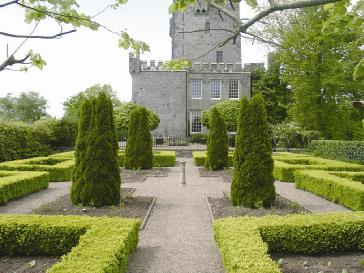
|
| Quinville House | An 18th century house, Lewis writes that it was rebuilt in the early 19th century in the Elizabethean style, home of the Singleton family. In 1906 Quinville was in the possession of James Butler Ievers. The property was bought by the McCausland family of Drenagh, county Derry in the 20th century. In the late 1990s the house was undergoing a major restoration by the owners, the Houlihan family. in 2012 it was offered for sale. |

|
| Rathluby | By the end of the 18th century Rathluby was in the possession of the Bridgeman family. The buildings were valued at £5 at the time of Griffith's Valuation when Henry Bridgeman occupied the house which he held from Eliza Piercey and it continued to be a Bridgeman home until the end of the 19th century. The house is now a ruin. | |
| Belvoir | Belvoir was an early 19th century house on the same site as an earlier building. It was the home of the Wilson family, valued at £32 in the mid 19th century. The house was burnt in 1888 when leased by the Wilson Lynches to Lady Loftus. It was not rebuilt though recorded as the seat of Maj. Wilson Lynch in 1894. Members of the Wilson Lynch family continued to live in the remaining wing until the mid 20th century. It is now a ruin. |
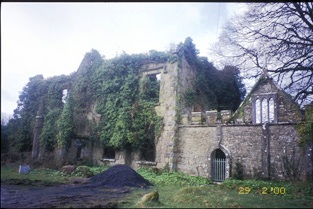
|
| Glenwood | Weir records Poole Gabbett in residence in 1810, Basil Davoren occupied the house in 1837 and John Gabbett at the time of Griffith's Valuation. He held it from George Studdert and it was valued at £10. Alice Studdert married General Frederick Maunsell and they lived at Glenwood which passed to their son Robert Maunsell. This house was the scene of an ambush in which eight Black and Tans were killed in 1920. The house no longer exists. | |
| Mount Baylee | In 1837 the residence of H. Bayley. Occupied by Susannah Baylee at the time of Griffith's Valuation, who held it from Henry Thomas Baylee. The buildings were valued at £8. Weir writes that in the 20th century Miss Edie Baylee married the father of the architect Percy le Clerc. The house is still lived in. | |
| Sunville | Occupied by T. Studdert in 1837 and by Robert Hanley at the time of Grifftith's Valuation who held the property from Thomas Prosser. Also known as Sion Ville. A building is still extant at the site. | |
| Leamaneigh More | Occupied by Patrick J. Coffey at the time of Griffith's Valuation and held from Sir Edward Fitzgerald. The buildings were valued at £10. During the 1940s this property seems to have been known as Waverley. An extensive farm is extant at the site. | |
| Stonehall | The home of the O'Briens, later Stafford O'Briens, at the beginning of the 18th century and later in the possession of the Fitzgeralds. By the beginning of the 19th century the house was in the hands of the McMahon family. At the time of Griffith's Valuation James McMahon was leasing Stonehall from the Stafford O'Briens, it was valued at less than £3. Later the home of the Whites who intermarried with the McMahons. It is no longer extant. | |
| Paradise | This was originally a 17th century house situated almost on the shore of the Shannon. In 1786 Wilson refers to it as "Paradise, the delightful seat of Mr. Henn, finely situated on the side of a high hill". It was altered in the 19th century. Many members of the Henn family were involved in the legal profession and lived in Dublin so the family did not inhabit the house much until the second half of the 19th century. In 1814 John Scott was residing in the house and Thomas Arthur in 1837. In the mid 1850s the house was unoccupied and Augustus Arthur was the immediate lessor. It was valued at over £17. The Henns began to reside soon afterwards. IN 1894 Slater refers to Paradise as the seat of Judge Henn. The Irish Tourist Association Survey File of the 1940s refers to rumours of the Colonel's intention to sell Paradise. Destroyed by fire in 1970. |

|
| Cornfield | Occupied by Westropp Ross in 1814 this house was in the possession of Major William Ball by the time of Griffith's Valuation, when the buildings were valued at £48. Later occupied by members of the Dawson family. The house no longer exists but a gate lodge is still extant. |

|
| Clenagh Castle | Home of the McMahons in the 18th century, Lewis refers to the ruined tower which was "once the residence of the McMahons". |
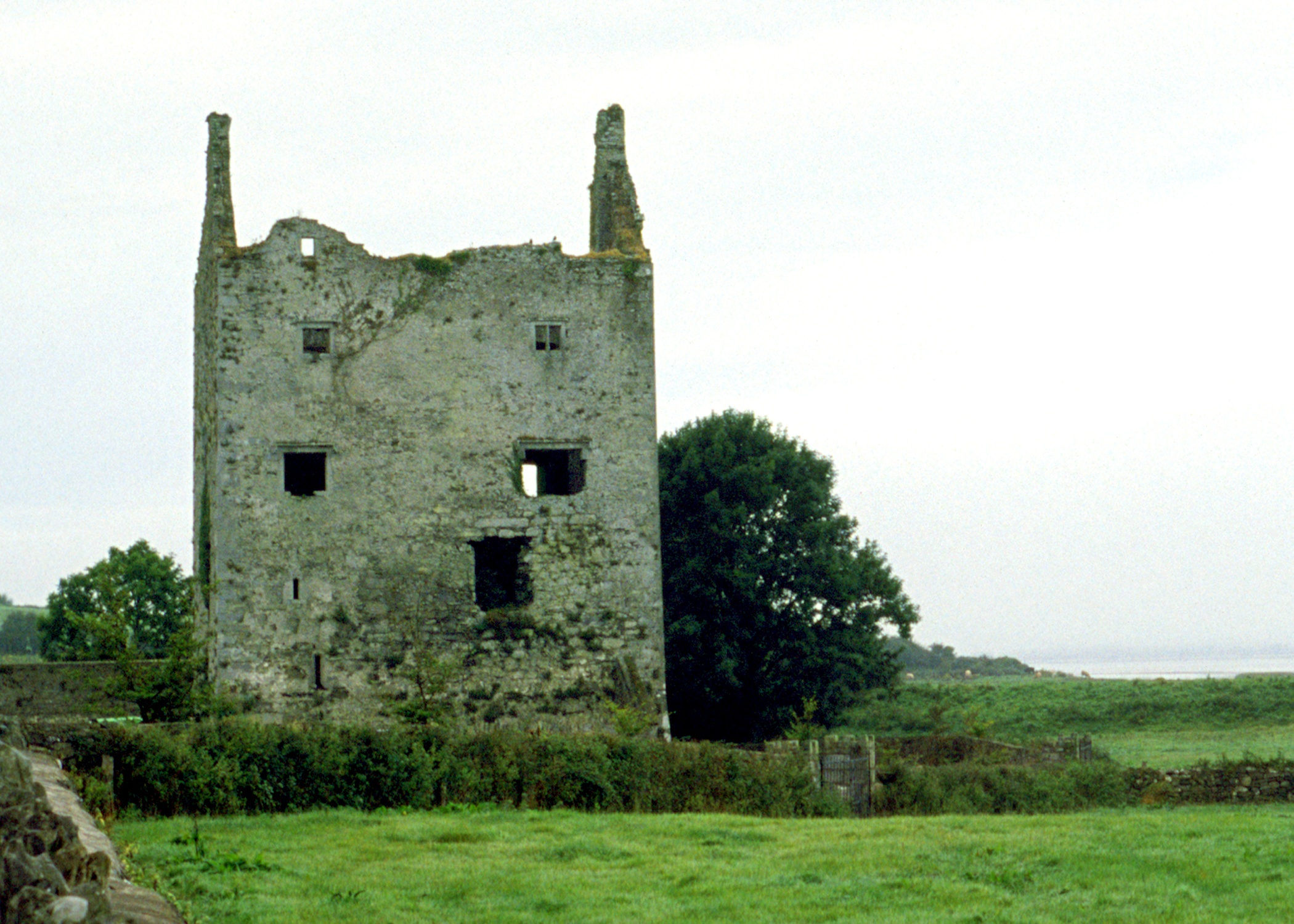
|
| Crovraghan | A house situated on the Wyndham estate, occupied by John Tatlow in 1814 and J. O'Donnell in 1837. James O'Donnell held the house, valued at just over £10, from Colonel George Wyndham at the time of Griffith's Valuation. Later the home of the Cannon family until the 1970s. |
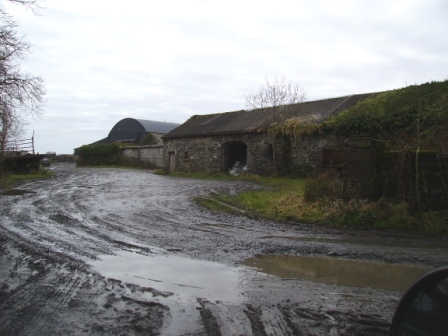
|
| Clonmacken | Built in 1700 by Reverend Edmund Palmer according to the Ordnance Survey Field Book, this two-storey house was occupied by Henry D'Esterre in 1814, by Captain Vereker in 1834 and by 1839 was the seat of John Brown Finch. In the early 1850s it was the residence of John Sharp, situated on the Lansdowne estate, it was held from Lawrence Kelly. | |
| Bunkers Hill | A mid 19th century house, the home of James Forost (1827-1907), author of ''The History and Topography of the County of Clare'' (1893), who held the house and 139 acres from Lord George Quin. He was the eldest son of William Frost and his wife Mary Ryan and he married Bedelia daughter of Augustine Moran of Willbrook. He left the house to the Dundon family who sold it to the Ryans circa 1917. Members of the Ryan family still live at Bunkers Hill. | |
| Teermaclane | Home of the Woulfe family in the 18th century, it became a ruin in the early part of the 19th century. |
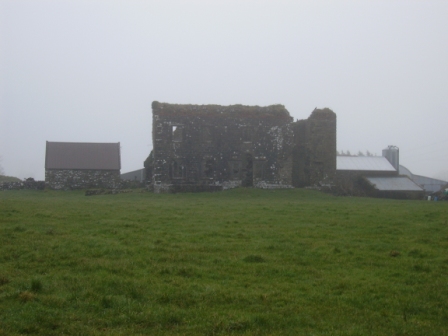
|
| Ballyhannon | Weir writes that this is a mid 19th century house and was the home of Thomas Studdert. This house valued at £24 was occupied by his representatives in 1906. It is still extant. |

|
| Clorhane | Home of Thomas Dalton in the mid 18th century and of the Fosbery family in the 19th century. Held by George Fosbery junior at the time of Griffith's Valuation when the buildings were valued at £11. Home of Francis Wise Browning in the early part of the 20th century following his marriage to Jane Philippa Fosberry daughter and co heiress of Thomas Fosberry of Kilgobbin and Clorane. Cussen writes that this house is now demolished. | |
| Farm Lodge | Marked as Farm Lodge on the first Ordnance Survey map this house on the De Vere estate was occupied by James Potter in the early 1850s when it was valued at £16. An extensive farm still exists at the site. | |
| Rockfield | The residence of Edward Fitzgerald in the first half of the 19th century, held by him from Captain Richard Gloster at the time of Griffith's Valuation and valued at over £11. | |
| Cartown | Built in 1763 Cartown was the residence of Mr Baldwin in 1826 and of John Edward Langford in 1837. In the early 1850s Griffith's Valuation records the vacant house as valued at £24, William Sheedy holding the whole townland from General James Caulfeild. By the late 19th century the house was in the possession of the Westropp family. This house is still extant and occupied. |

|
| Mellon | The Westropp family are recorded as "of Mellon" from the early 18th century. Bence Jones dates the present house from circa 1780, the Ordnance Survey Field Name Books from 1812. Inhabited by Mrs Jane Westropp (nee Dawson) in the early 1850s. It was valued at £36. This 3 storied house was still in Westropp possession in the late 20th century. It is now run as a stud. |
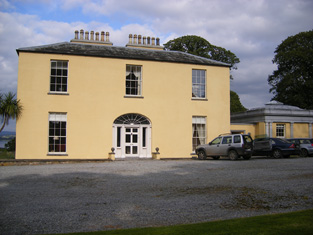
|
| Mount Pleasant | The Ordnance Survey Name Books record that this house was built in the mid 18th century by a Mr Star. It was a neat farm house occupied by Mrs Hill in 1837 and by Thomas Hill at the time of Griffith's Valuation. He held the property from Daniel Leahy and the buildings were valued at over £11. This house is still extant and occupied. |
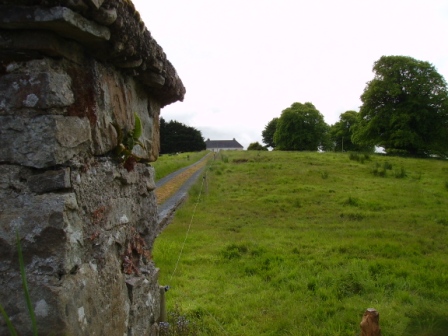
|
| Shannon Grove | Originally the home of the Bury family, Earls of Charleville, overlooking the Shannon estuary. The Ordnance Survey Name Books record this house as four-storied, built in 1709. Bence Jones dates this house from the early 18th century. Lewis writes that Shannon Grove was the old family mansion of the Earls of Charleville and "now the residence of Bolton Waller". Bolton Waller held the property in fee in the early 1850s when the buildings were valued at £43 and the demesne was over 400 acres. Bought by John Sheehy of Askeaton in 1860 and remained in the possession of his descendants until the mid 20th century. The house is still extant and occupied. |
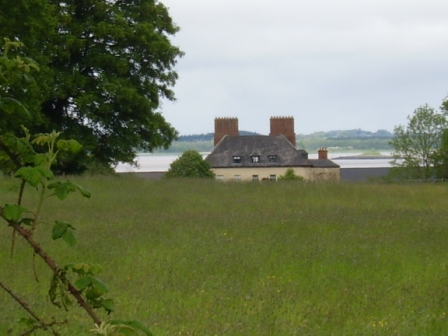
|
| Castletown | The main residence of the Waller family in the 18th and 19th centuries, now demolished. The house was valued at £80 in the early 1850s when it was the residence of the Reverend William Waller. By 1906 its value was reduced to £72.5 shillings and it was occupied by the Reverend John Thomas Waller who was also resident in 1894. The surveyor for the Irish Tourist Association Survey in 1944 refers to the house being recently levelled to the ground. | |
| Bushyisland | This house was the residence of Peter Lowe in 1814 and in 1837. John Peppard MD was the occupier at the time of the first Ordnance Survey and of Griffith's Valuation. He held the property from Bolton Waller and had converted the house into an asylum. | |
| Kilbreedy | A house occupied by Michael Nash at the time of Griffith's Valuation and held from the Reverend William Waller, valued at £11. | |
| Stonehall | A house built 1803 and situated on the Waller estate in the mid 19th century and occupied by the Langford family from at least the early 19th century. This house is still extant and occupied and the property includes an open farm. |

|
| Copsewood | Copsewood Cottage is marked on the first Ordnance Survey map at this site. A much larger house was built in the mid 19th century for Major General Caulfeild. It was valued at £36 at the time of Griffith's Valuation and at £63 in 1906. It remained in the possession of the General's descendants until 1919 when it was bought by the Salesian Fathers who started an agricultural school. It is now a secondary school run by the Salesian Order. |

|
| Summerville | Described by Lewis as an ancient seat of Lord Charleville "now occupied by an agent". In the early 1850s Patrick and Michael O'Donnell were resident and they held the property from General James Caulfeild. | |
| Ballysteen | Home of the Westropp family in the 18th and 19th centuries and occupied by Colonel John Westropp in 1814. The Ordnance Survey Field Name Books circa 1840 state that John Westropp built the house in 1809 on the site of the former house. By 1837 it had passed to his nephew Edmond Odell who had assumed the name Westropp. Ballysteen valued at £40 was held by Edmund Westropp in fee at the time of Griffith's Valuation and in 1906 by Richard Westropp when its value had increased to almost £45. |
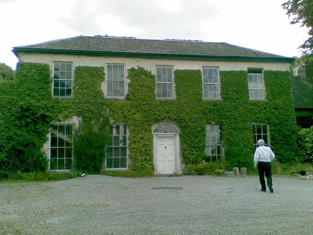
|
| Glenagaureen | The Ordnance Survey Field Name Books circa 1840 record an unoccupied house named Glenagordon in Ballysteen, built 1826 by Edmund Odell Westropp. A vacant house valued at £16 and held by Edmund Westropp was recorded in Griffith's Valuation for Ballysteen. | |
| Milltown | The Reverend Champagne was resident at Milltown from at least 1837. He is recorded as the occupier of this house in the early 1850s when he held the house valued at £28 from the Reverend Tyrell Evans. | |
| Holly Park | In 1786 Wilson describes Holly Park as "the seat of Richard Taylor, it is very commodious and well-situated, having convenient offices and extensive demesnes". Lewis writes that Holly Park was the ancient residence of the Taylor family "now the property of Sir Aubrey de Vere". However Griffith's Valuation records Richard Taylor holding Holly Park in the early 1850s in fee. It was valued at £36. In 1894, Slater referred to it as the seat of George Taylor and in 1906 George Taylor held 277 acres of untenanted land and a mansion house valued at £34 at Currahchase North. Sold by the Taylors in 1939. Feheney writes that the son of Tom Clarke, one of the leaders executed in 1916, bought Holly Park from the Land Commission in the 1940s. The home of John Philip Cohane in the 1970s who had restored the house after a fire. It is still extant. | |
| Ballynolan | This 3 storied house was the seat of the Reverend Thomas Westropp, rector of Ardcanny, built by him [his father?] in 1797. It was occupied by H. Potter esquire in 1837 and by Peter W. Morgan at the time of Griffith's Valuation who held it in fee with a demesne of 98 acres. Valued at £11.10 shillings in 1906 and occupied by Sarah E. M. Westropp. Still extant and occupied. |
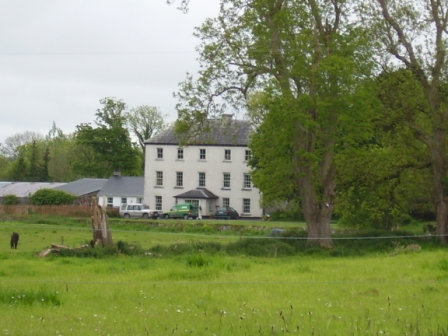
|
| Ballynacourty | A house occupied by Thomas Davenport from at least 1837. The Ordnance Survey Field Name Books circa 1840 state that the house was built by John Evans "about 90 years" previously. It was two storeys high. The house was valued at £15 in the early 1850s and was held from Daniel D. Power. The house is still extant and now owned by John Feheney. For more information see www.iverusresearchfoundation.com (See ‘Research Notes’, Ballinacourty House). |

|
| Bolane | Bollane Cottage was occupied by Arundel Hill in 1837. A house at Bolane was the residence of Thomas Hanly in the early 1850s and valued at £16. It was held from Daniel D. Power. A house is still extant at this location and occupied. |
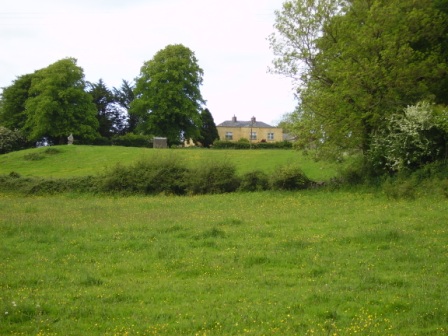
|
| Ballynacarriga | The Ordnance Survey Field Name Books describe this house as "falling into decay", the property of Mr Enright. By 1837 a Mr Dawson was the proprietor of Ballynacarriga House and in the early 1850s it was occupied by Dawson L. Westropp. In 1906 Ballynacarriga valued at £20.10 shillings was occupied by Norris Richard Russell. | |
| Ballynacarriga | Built in 1819 this house was occupied by a member of the Hill family at the time of the Ordnance Survey who was renting the property from Mrs Hurst . Lewis records H. Hurst as resident in 1837 and in the early 1850s Captain Richard Gloster held this house valued at £21 in fee. This house is now known as Rockfield. |

|
| Castlegrey | A house in the possession of the Langford family in the 19th century, the residence of G. Langford in 1837 and of Charles Wiedenham Fosbery in the early 1840s and 1850s. He held the property from Mrs Jane Langford. It was valued at £11. Slater refers to it as the seat of Captain Frederick Verschoyle in 1894. Some buildings are still extant at the site. | |
| Court/Kildimo Court | In 1837 Lewis wrote that Kildimo Court "which is nearly entire was the seat of the Hartstonge family". The Hartstonges appear to have inherited this property from the Widenhams. In 1786 Wilson refers to Court as the seat of Sir Harry Hartstronge and notes that "a bridge is now building at the ferry of Court but the house is in ruins". The property called Court Castle is labelled "in ruins" on the 1st edition Ordnance Survey map. A house labelled "Court" appears in the same townland on both the 1st and 25-edition maps. Buildings are still present at this location. | |
| Brickhill | The home of the Maghlin family in the early 18th century, it passed by marriage to the Blood family. Occupied by the Lysaght family in the mid 18th century. Edward Lysaght, songwriter and lawyer, known as 'Pleasant Ned' was born at Brickhill in 1763. The house is not named on the first Ordnance Survey map and a 20th century house now occupies the site. [Grid reference is approximate]. | |
| Castle Hewson | The seat of the Hewson family of county Limerick. William Hewson was in residence at the time of Griffith's Valuation when the buildings were valued at £23. Castle Hewson is no longer occupied but William Hewson, a descendant of George Hewson, resides in a building closeby and is restoring the property. A tower house stands beside the house. |

|
| Cooper Hill | The residence of James Cooper in 1814 and occupied by Mrs [Honora] Cooper in 1837. Inherited by James Cooper Tuthill circa 1844 who then assumed the surname Cooper. The house was valued at £45 at the time of Griffith's Valuation and in 1906 when it was occupied by James Cooper. It was advertised for sale in ''Country Life'' (28 April 1955), bought by Cement Ltd who ran a model dairy farm on the property for some years. A large dairy enterprise still operates on the property. The house is a ruin. |

|
| Faha | A property that was in the possession of the Tuthill family from the early 18th century, Wilson refers to it as Mr. Tuthill's seat in 1786. Occupied by Christopher Tuthill in 1814 and by his son George in 1837. Held by George Tuthill in fee at the time of Griffith's Valuation when the buildings were valued at £60. Thompson Russell lived at Faha in the second half of the 19th century. Valued at £52 in 1906 and occupied by George Taylor who held it with 308 acres of untenanted land. It is now a ruin. |
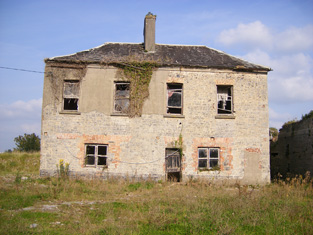
|
| Corcamore | A house situated on the Barker estate and occupied by Thomas Gleeson in the mid 19th century and valued at £18. [Grid reference is approximate]. | |
| Cragbeg | A house situated on the estate of Lord Clarina, occupied by Vokes in the 1770s and in 1786. It was leased to the Vandeleur family in the mid 19th century. Major Thomas Vandeleur was the occupier and the buildings were valued at £38. Occupied by Richard Parson in 1814, by G. Vandeleur in 1837 and by William Henry Harkness in the 1870s. Slater notes Lieut-Col. Lionel E. Massey as the owner in 1894. Still extant and occupied. |

|
| Elm Park | The records suggest that this house was built post 1814 and pre 1837 though there may have been an earlier property as Wilson refers to "Elm" as the seat of General Massey in 1786. Bence Jones writes that it was an early 19th century house. It was the home of the Massey family, Barons Clarina, in the 19th century. The buildings were valued at £90 at the time of Griffith's Valuation and in 1906. Bought by Patrick King in 1925 and home of the King family until 1956, now demolished. |

|
| Tervoe | Bence Jones writes that the house was built in 1776 by Colonel W.T. Monsell MP on the site of an earlier house. Wilson refers to it in 1786 as "the pleasant seat of W.T. Monsell". In 1894 Slater notes it as a residence of Lord Emly. A De La Poer grandson of the 1st Baron Emly succeeded to Tervoe in the 20th century and it was demolished in the 1950s. A detailed description of the interior of the house is given by the Irish Tourist Association surveyor in 1943. |

|
| Kilrush | A house occupied by Daniel Gabbott and held from Tottenham Harvey at the time of Griffith's Valuation. The house was valued at £40 and was surrounded by 3 acres of land. It was situated on the Barrington estate. [Marked as Thorn Ville on the first Ordnance Survey map]. | |
| Coolraine House | Occupied by John Vereker at the time of Griffith's Valuation, valued at £30 and held from the Marquess of Lansdowne. It was still extant until the 1940s but the site is now occupied by suburban housing. | |
| Moylish | The Ordnance Survey Name Book shows Arthur Gloster as proprietor of this townland circa 1840 and Moylish House is marked on the first Ordnance Survey map. By the time of Griffith's Valuation Moylish valued at £24 was occupied by Lawrence Kelly who held the property from John Judde. Moylish is now the site of the Limerick Institute of Technology. | |
| Bellevue | The description in the National Inventory of Architectural Heritage records the building of this house as circa 1820 and that it was the home of the artist Douglas Alexander (1871-1945), one of three brothers who were prominent Quaker merchants in the city of Limerick. At the time of Griffith's Valuation Bellevue valued at £35 was occupied by William Alexander. Another house occupied by James Alexander and valued at £31 stood close by. Both houses were held from the Marquis of Lansdowne. Later this house was the home of the Cleeves family, toffee makers. |

|
| Ardhu | A house built post 1850, the seat of the Rose family at the beginning of the 20th century. Now functions as the Clarion Hotel suites. |
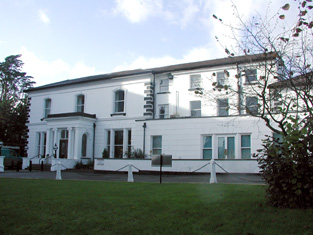
|
| Tivoli | Marked on the first Ordnance Survey map, Tivoli Cottage valued at £48 was occupied by Major Wheeler and held from Sir Matthew Barrington at the time of Griffith's Valuation. Since 1952 it has been the centre of a boys' secondary school known as Villiers School. |

|
| Ballynort | A Taylor residence which passed by marriage to the Massy family. In1786 Wilson describes it as" the pleasant seat of Mr. Massey". The townland of Ballynort, 657 acres, was held in fee by Standish O'Grady and E.T. Massy at the time of Griffith's Valuation. This house is marked "in ruins" on the first Ordnance Survey map. The buildings were valued at £4+. There is no trace of the house on the 25-inch Ordnance Survey map of the 1890s. | |
| Kilgobbin | Occupied by George Fosberry in the early 1850s held from the Earl of Dunraven and valued at £30. An inventory of the furniture at Kilgobbin was compiled in June 1923 for A.P.Pollock. It is still extant. | |
| Dromore Castle | In 1868 the building of Dromore Castle began. It was an elaborate country retreat for the 3rd Earl of Limerick designed by Edward William Godwin. In 1906 this mansion house was valued at £75.10 shillings. The 4th Earl of Limerick did not visit Ireland very much and the castle was sold in 1939. In 1944 the Irish Tourist Association surveyor refers to the castle as the property of Mr M.McMahon, a timber merchant of Limerick, who bought the property in 1941 for a reputed £8,000. By the mid 20th century it had fallen into disrepair and the roof was taken off. Plans to develop the site and to demolish the ruin are current issues discusssed in the local and national press. |
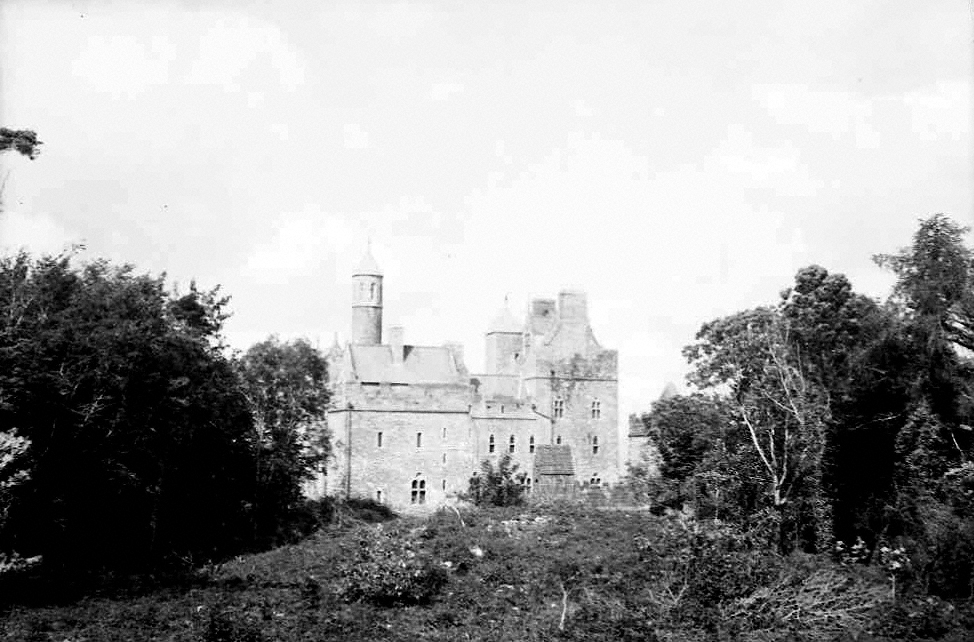
|
| Pass House | In 1786 Wilson writes that Pass House was the seat of Mr. Peacock. By the time of Griffith's Valuation the house was occupied by Solomon Frost, leasing from the Peacock estate and valued at over £5. The property does not appear on the 25-inch Ordnance Survey map of the 1890s. | |
| Feenagh House | Feenagh House is described as "in ruins" on the 1st edition Ordnance Survey map and has almost disappeared by the publication of the 25-inch edition in the 1890s. In 1786 Wilson refers to "Fenagh House" as the seat of Mr. Wilson. By the time of Griffith's Valuation, the townland in which it was situated was the subject of Court of Chancery proceedings. Some fragments of the walls are still visible. |

